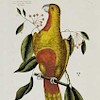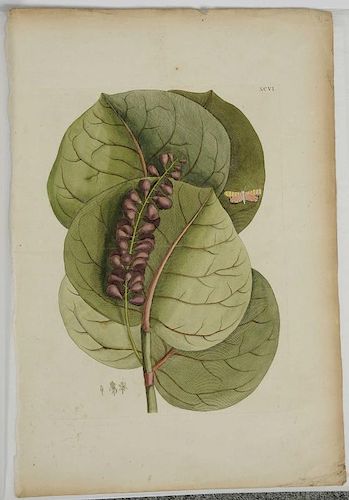Mark Catesby
Bid Increments
| Price | Bid Increment |
|---|---|
| $0 | $10 |
| $100 | $25 |
| $500 | $50 |
| $1,000 | $100 |
| $2,000 | $200 |
| $3,000 | $250 |
| $5,000 | $500 |
(British, 1679-1749)
The Mangrove Grape or Sea Grape, Pl. XCVI (T.96), from The Natural History of Carolina, Florida and The Bahama Islands, 1754 edition, hand colored engraving on laid paper with "J. Honig & Zoonen" watermark,
Note: In chapter 11 of Henrietta McBurney’s book, The Curious Mr. Catesby, edited by E. Charles Nelson and David J. Elliott for the Catesby Commemorative Trust, she indicates that Georg Dionysius Ehret was the artist who etched The Mangrove or Sea Grape plate:
"Catesby also worked with contemporary and younger artists. In 1736, the German Georg Dionysius Ehret (1708–1770) came to London from Nuremberg while Catesby was working on the seventh part of his book. With his botanical training, intuitive sense of design, and virtuoso skills as a painter—he had been trained in Paris to paint on vellum—Ehret was to become the most outstanding botanical artist of the eighteenth century to work in England. His patrons included Hans Sloane, the physician and collector Richard Mead, and several wealthy garden owners. Catesby, who probably met Ehret through Sloane, was clearly impressed by his work and began an association with him. During his period of working with Catesby, Ehret produced ten watercolors that were etched by Catesby for The natural history of Carolina, Florida and the Bahama islands, including one of smooth sumac (Rhus glabra), for which the preparatory study survives in the Natural History Museum, London. Ehret also executed two etchings for Catesby’s book, one after a watercolor by Catesby of the sea-grape (Coccoloba uvifera) and the other after his own spectacular watercolor painting of the bull bay or southern magnolia (Magnolia grandi?ora)," p.152.
In addition to the uncolored background, this version of the Mangrove or Sea Grape uses roman numerals instead of arabic numerals for the plate number, i.e. XCVI rather than 96. It appears to be rare without the colored back ground.
(British, 1679-1749)
The Mangrove Grape or Sea Grape, Pl. XCVI (T.96), from The Natural History of Carolina, Florida and The Bahama Islands, 1754 edition, hand colored engraving on laid paper with "J. Honig & Zoonen" watermark,
Note: In chapter 11 of Henrietta McBurney’s book, The Curious Mr. Catesby, edited by E. Charles Nelson and David J. Elliott for the Catesby Commemorative Trust, she indicates that Georg Dionysius Ehret was the artist who etched The Mangrove or Sea Grape plate:
"Catesby also worked with contemporary and younger artists. In 1736, the German Georg Dionysius Ehret (1708–1770) came to London from Nuremberg while Catesby was working on the seventh part of his book. With his botanical training, intuitive sense of design, and virtuoso skills as a painter—he had been trained in Paris to paint on vellum—Ehret was to become the most outstanding botanical artist of the eighteenth century to work in England. His patrons included Hans Sloane, the physician and collector Richard Mead, and several wealthy garden owners. Catesby, who probably met Ehret through Sloane, was clearly impressed by his work and began an association with him. During his period of working with Catesby, Ehret produced ten watercolors that were etched by Catesby for The natural history of Carolina, Florida and the Bahama islands, including one of smooth sumac (Rhus glabra), for which the preparatory study survives in the Natural History Museum, London. Ehret also executed two etchings for Catesby’s book, one after a watercolor by Catesby of the sea-grape (Coccoloba uvifera) and the other after his own spectacular watercolor painting of the bull bay or southern magnolia (Magnolia grandi?ora)," p.152.
In addition to the uncolored background, this version of the Mangrove or Sea Grape uses roman numerals instead of arabic numerals for the plate number, i.e. XCVI rather than 96. It appears to be rare without the colored back ground.
(British, 1679-1749)
The Mangrove Grape or Sea Grape, Pl. XCVI (T.96), from The Natural History of Carolina, Florida and The Bahama Islands, 1754 edition, hand colored engraving on laid paper with "J. Honig & Zoonen" watermark,
Note: In chapter 11 of Henrietta McBurney’s book, The Curious Mr. Catesby, edited by E. Charles Nelson and David J. Elliott for the Catesby Commemorative Trust, she indicates that Georg Dionysius Ehret was the artist who etched The Mangrove or Sea Grape plate:
"Catesby also worked with contemporary and younger artists. In 1736, the German Georg Dionysius Ehret (1708–1770) came to London from Nuremberg while Catesby was working on the seventh part of his book. With his botanical training, intuitive sense of design, and virtuoso skills as a painter—he had been trained in Paris to paint on vellum—Ehret was to become the most outstanding botanical artist of the eighteenth century to work in England. His patrons included Hans Sloane, the physician and collector Richard Mead, and several wealthy garden owners. Catesby, who probably met Ehret through Sloane, was clearly impressed by his work and began an association with him. During his period of working with Catesby, Ehret produced ten watercolors that were etched by Catesby for The natural history of Carolina, Florida and the Bahama islands, including one of smooth sumac (Rhus glabra), for which the preparatory study survives in the Natural History Museum, London. Ehret also executed two etchings for Catesby’s book, one after a watercolor by Catesby of the sea-grape (Coccoloba uvifera) and the other after his own spectacular watercolor painting of the bull bay or southern magnolia (Magnolia grandi?ora)," p.152.
In addition to the uncolored background, this version of the Mangrove or Sea Grape uses roman numerals instead of arabic numerals for the plate number, i.e. XCVI rather than 96. It appears to be rare without the colored back ground.
(British, 1679-1749)
The Mangrove Grape or Sea Grape, Pl. XCVI (T.96), from The Natural History of Carolina, Florida and The Bahama Islands, 1754 edition, hand colored engraving on laid paper with "J. Honig & Zoonen" watermark,
Note: In chapter 11 of Henrietta McBurney’s book, The Curious Mr. Catesby, edited by E. Charles Nelson and David J. Elliott for the Catesby Commemorative Trust, she indicates that Georg Dionysius Ehret was the artist who etched The Mangrove or Sea Grape plate:
"Catesby also worked with contemporary and younger artists. In 1736, the German Georg Dionysius Ehret (1708–1770) came to London from Nuremberg while Catesby was working on the seventh part of his book. With his botanical training, intuitive sense of design, and virtuoso skills as a painter—he had been trained in Paris to paint on vellum—Ehret was to become the most outstanding botanical artist of the eighteenth century to work in England. His patrons included Hans Sloane, the physician and collector Richard Mead, and several wealthy garden owners. Catesby, who probably met Ehret through Sloane, was clearly impressed by his work and began an association with him. During his period of working with Catesby, Ehret produced ten watercolors that were etched by Catesby for The natural history of Carolina, Florida and the Bahama islands, including one of smooth sumac (Rhus glabra), for which the preparatory study survives in the Natural History Museum, London. Ehret also executed two etchings for Catesby’s book, one after a watercolor by Catesby of the sea-grape (Coccoloba uvifera) and the other after his own spectacular watercolor painting of the bull bay or southern magnolia (Magnolia grandi?ora)," p.152.
In addition to the uncolored background, this version of the Mangrove or Sea Grape uses roman numerals instead of arabic numerals for the plate number, i.e. XCVI rather than 96. It appears to be rare without the colored back ground.
Condition
In house shipping. Brunk Auctions provides in-house shipping via UPS Ground (signature required) for many items. Brunk Auctions will provide a shipping quote which includes shipping, materials, labor and insurance. Insurance is based on the selling price and premium.
In order to provide an accurate shipping quote please provide the following:
- Shipping address
- Shipping method: if you have a UPS or Fed Ex account # we can bill your account 3rd Party and you can arrange payment for materials, labor and insurance. If you have your own insurance please send a signed waiver of liability.
Shipping arrangements are made only after the invoice is paid. The payment for shipping is a separate charge from payment of your lots.
Sales Tax: If you live in North Carolina and/or pick up from the auction house, and do not have a valid resale tax number on file with us, you MUST pay North Carolina state sales tax. The NC Sales Tax will not apply to any items being shipped out of state (unless the client resides in North Carolina) or to those clients with a resale tax number.




